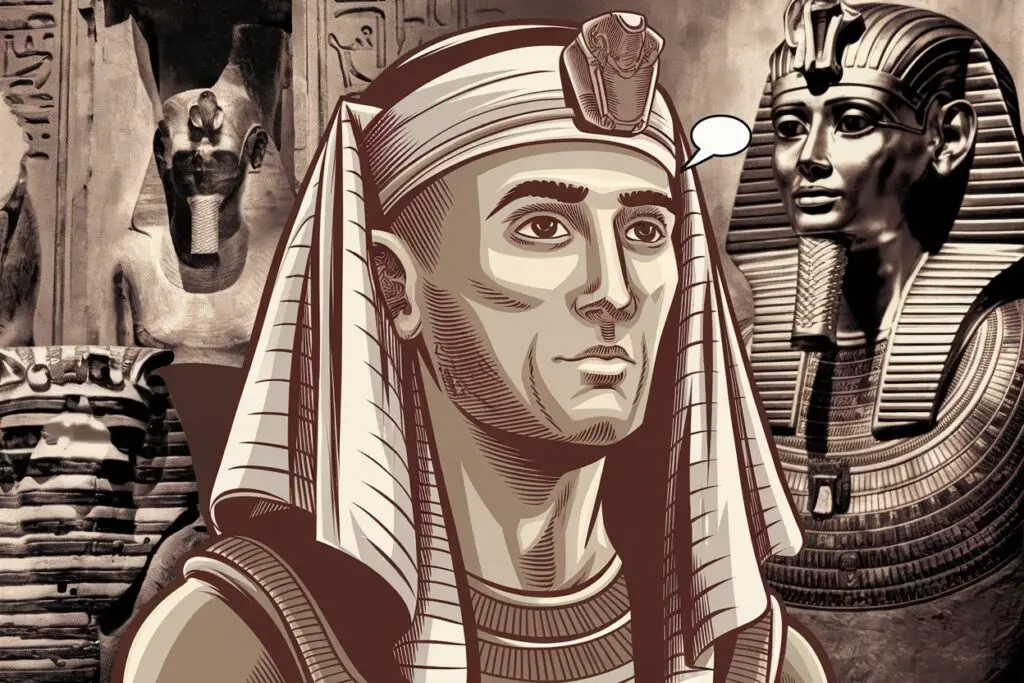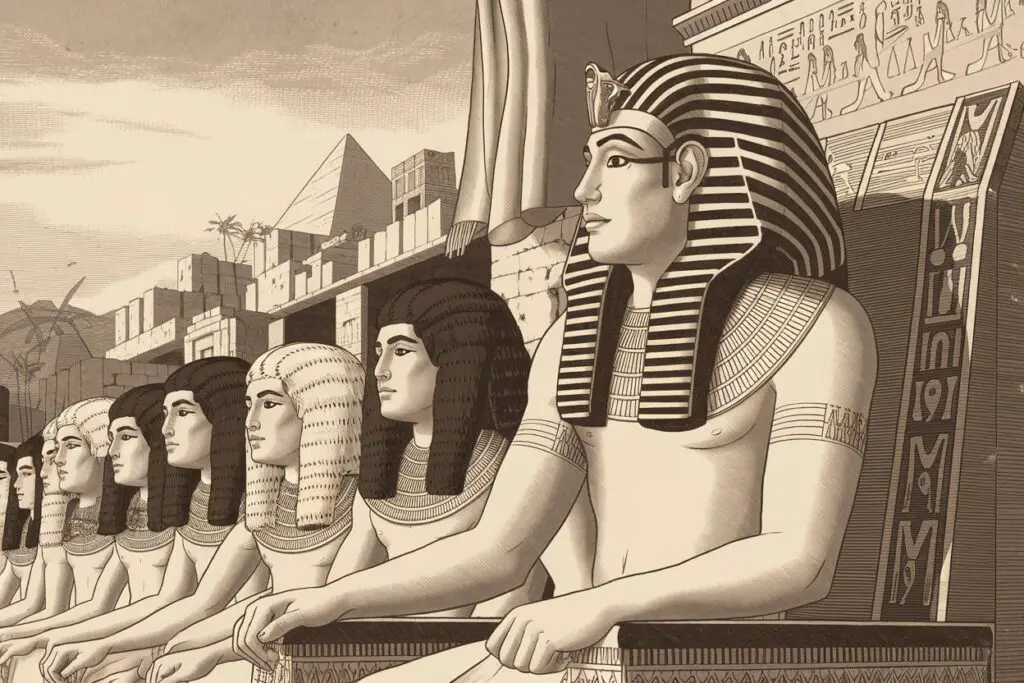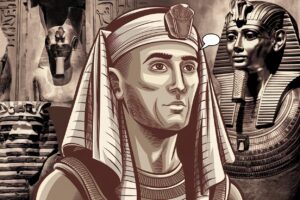Hygiene and Protection from Lice in a Hot Climate
In the scorching heat of ancient Egypt, maintaining personal hygiene was more than just a daily routine—it was a necessity for survival. The intense sun, combined with a civilization that thrived along the Nile, created an environment where lice and other parasites could flourish. To combat this, Egyptians—especially the elite—adopted the practice of shaving their heads entirely. This wasn’t just a matter of preference; it was a strategic move to keep lice infestations at bay and maintain cleanliness in a time before modern sanitation.

Priests took this to an extreme, shaving their entire bodies every other day to uphold ritual purity and prevent pests from taking hold. But shaved heads presented another problem: exposure to the relentless Egyptian sun. This is where wigs came in. Made from human hair, palm fibers, or even wool, wigs provided a protective barrier that shielded the scalp while allowing heat to escape. Unlike natural hair, wigs could be removed and thoroughly cleaned, further reducing the risk of lice.
Far from being just a fashion statement, this dual practice of shaving and wearing wigs was a calculated response to environmental challenges. It allowed Egyptians to remain both hygienic and comfortable while also maintaining their highly stylized appearance—a perfect blend of practicality and cultural sophistication.
Religious and Symbolic Reasons for Shaving Heads
In ancient Egypt, shaving one’s head was more than just a practical choice—it was a deeply symbolic and religious act. Priests, in particular, adhered to strict purification rituals that required complete hair removal, including body hair. This practice was rooted in the belief that bodily hair could harbor impurities, which were considered offensive to the gods. To maintain ritual cleanliness, priests would shave their heads regularly, ensuring they remained in a state of spiritual purity while performing sacred duties.
Beyond hygiene, the act of shaving carried profound religious connotations. Many Egyptian deities, such as Ra, the sun god, were often depicted with smooth, hairless heads, reinforcing the idea that baldness was associated with divine purity. Some scholars suggest that the reflective quality of a shaved scalp symbolized a connection to the solar deities, particularly Ra, whose brilliance was mirrored in the smooth, shining heads of his earthly servants.
Hair itself was also a potent symbol in Egyptian culture, often representing vitality and life force. The removal of hair could signify a spiritual transition, a form of mourning, or even a rebirth. This is evident in Egyptian mythology, where goddesses like Isis were sometimes depicted cutting their hair as an expression of grief or transformation. Similarly, in funerary practices, shaving the head was linked to the journey into the afterlife—shedding one’s earthly form before undergoing spiritual renewal.
The practice of head shaving wasn’t exclusive to priests. Other religious functionaries and initiates also shaved their heads as a sign of devotion. This tradition extended beyond Egypt, influencing neighboring cultures where shaved heads became a mark of religious commitment, subordination, or purification. In this way, the Egyptian practice of head shaving was not just a personal choice but a sacred tradition that underscored their connection to the divine.
How Wigs Signified Status and Wealth in Egyptian Society
In ancient Egypt, wigs were far more than functional accessories—they were powerful markers of wealth, rank, and social identity. The elite, including royalty, high-ranking officials, and wealthy individuals, wore elaborate wigs to distinguish themselves from the lower classes. The number of wigs one owned directly reflected their social standing; affluent Egyptians often possessed multiple wigs for different occasions, while commoners, if they could afford one at all, typically had a single, simpler version.

The materials used in wig-making also played a crucial role in signaling status. The most luxurious wigs were crafted from human hair, which was a highly valued commodity, often exchanged alongside gold and incense in Egypt’s barter economy. Less expensive wigs, worn by those of lower means, incorporated plant fibers or sheep’s wool. The craftsmanship involved in making these wigs was intricate—some took up to 200 hours to complete—making them exclusive to those who could afford such luxury.
Beyond material wealth, wigs carried symbolic significance. Extravagantly styled wigs, adorned with braids, beads, or even gold decorations, emphasized the wearer’s high position. Some styles were so elaborate and heavy that they required assistance to don. Ultimately, wigs in ancient Egypt functioned as visible indicators of privilege, ensuring that social hierarchies remained unmistakably clear.
The Materials Used for Egyptian Wigs—Human Hair, Palm Fibers, and Wool
Ancient Egyptian wigs were more than just fashion accessories; they were meticulously crafted symbols of status, hygiene, and religious significance. The materials used in their construction varied based on the wearer’s social standing, with the most luxurious wigs reserved for the elite. Human hair was the most prized material, often sourced through trade and even bartered alongside gold and incense. These wigs, sometimes blended with black sheep wool for added texture and volume, were worn by the wealthiest Egyptians, including royalty and high-ranking officials (Internet Archaeology, Fletcher & Salamone).
For those who couldn’t afford human hair wigs, alternatives were available. Plant fibers, including palm fibers, served as a more economical choice, though their use was less common than previously believed. Horsehair was another option, though it was primarily reserved for lower-status individuals. Regardless of the material, Egyptian wig-makers employed sophisticated techniques, constructing a mesh base where individual strands were secured using beeswax and conifer resin. These adhesives helped maintain the wig’s structure despite Egypt’s hot climate, ensuring durability and style.
The craftsmanship behind these wigs was remarkable. A fully reconstructed example of an 18th-dynasty wig, housed in the British Museum, revealed that creating such an intricate piece required approximately 200 hours of labor. The process involved plaiting the hair into a fine mesh, looping and securing individual strands, and then setting the style with natural adhesives. Surprisingly, these wigs were not excessively heavy, with estimates placing their weight between 0.5 to 1 kg, making them practical for everyday wear.
Ultimately, wigs in Ancient Egypt were more than mere adornments. They reflected social hierarchy, religious purity, and advanced craftsmanship, showcasing the ingenuity of Egyptian artisans in an era where appearance and symbolism were deeply intertwined.
Why Priests and Royalty Embraced the Bald Look
In ancient Egypt, baldness was far more than a matter of personal preference—it was a deliberate and deeply symbolic choice, particularly for priests and members of the royal family. Priests, in particular, were required to maintain a strict standard of cleanliness, which meant shaving not just their heads but their entire bodies, including eyebrows and eyelashes. This practice was rooted in both religious purity and practical hygiene; by removing all hair, priests minimized the risk of lice and other contaminants that could compromise their sacred duties (Internet Archaeology, Fletcher & Salamone).
For royalty, the decision to shave their heads was more strategic. While pharaohs and high-ranking officials were often depicted wearing elaborate wigs, their natural baldness served an important function. A clean-shaven head provided the perfect base for ceremonial headdresses and crowns, which symbolized divine authority. Pharaohs were seen as intermediaries between the gods and the people, and their physical appearance needed to reflect this exalted status [(Perplexity facts)]. Additionally, the bald look helped distinguish the elite from commoners, reinforcing social hierarchy. Although members of the working class often wore their natural hair, the upper classes embraced shaved heads as a mark of refinement, power, and ritualistic devotion [(Claude facts)].
This practice wasn’t just about appearance—it was a statement of power, purity, and divine connection. Whether through the rigorous grooming rituals of priests or the symbolic baldness of royalty, shaving one’s head was a cultural cornerstone of ancient Egyptian society, blending practicality with profound spiritual meaning.
The Role of Wigs in Religious Ceremonies and Burials
Ancient Egyptians placed immense significance on appearance, believing that one’s physical presentation influenced their spiritual journey. This belief extended to wigs, which were not mere fashion accessories but held profound religious and ceremonial importance. Wigs were often worn during temple rituals, where priests, who typically shaved their heads for purity, donned them to symbolize their elevated spiritual status. These wigs, crafted from human hair and secured with beeswax, were seen as sacred adornments that allowed priests to present themselves appropriately before the gods.
In burial practices, wigs played an essential role in ensuring the deceased transitioned properly into the afterlife. Egyptian funerary customs emphasized the need for the dead to appear as they did in life, as they believed recognition by the gods was crucial for resurrection. High-status individuals were often buried with elaborate wigs, sometimes even separate from their bodies, as part of their burial goods. Some wigs found in tombs were specifically crafted for funerary purposes, featuring intricate braiding and gold embellishments, indicating their symbolic rather than functional use.
The presence of wigs in both religious ceremonies and burials underscores the Egyptians’ deep connection between beauty, spirituality, and the afterlife. Whether worn by the living in sacred rituals or placed alongside the dead in tombs, wigs were a testament to the civilization’s meticulous approach to both religious devotion and the journey beyond death.
How Ancient Egyptian Hair Practices Influenced Later Cultures
Ancient Egypt’s approach to haircare and grooming didn’t just stay within the boundaries of the Nile—it rippled across civilizations, shaping fashion, religious customs, and even hygiene practices for centuries. The Egyptians’ preference for shaved heads and elaborate wigs wasn’t just a stylistic choice; it was a statement of status, cleanliness, and spirituality. These traditions found their way into neighboring cultures, influencing everything from Greek coiffures to the powdered wigs of European aristocracy.
One of the most significant impacts was on hygiene. The Egyptians shaved their heads to combat lice and the relentless desert heat, a practice that later influenced Greek and Roman societies. In ancient Greece, barbershops became social hubs where men had their hair trimmed and styled, a custom that may have stemmed from Egyptian grooming habits. The Romans, too, adopted elaborate hairstyles and wigs, particularly among the elite. Wealthy Roman women often wore wigs made from imported hair, a trend that mirrored the Egyptian practice of using wigs as symbols of status and wealth.
Religious and ceremonial influences were equally profound. Egyptian priests shaved their heads as a sign of purity, a tradition that echoed in later religious orders. Buddhist monks, Catholic priests, and even medieval European monks embraced head-shaving as a mark of devotion and humility. The symbolic use of wigs also persisted; in 17th and 18th-century Europe, powdered wigs became synonymous with nobility, echoing the Egyptian association of wigs with power and prestige.
Even the craftsmanship of Egyptian wigs left a lasting legacy. Their intricate construction techniques—using beeswax, resin, and tightly woven human hair—set a precedent for wig-making that endured for millennia. These methods were refined and passed down through the ages, influencing wig-making in Renaissance Europe and beyond.
Ultimately, Egypt’s haircare customs weren’t just about aesthetics; they were a blueprint for personal grooming, religious expression, and social hierarchy that transcended time and geography. From ancient Rome to 18th-century France, echoes of Egyptian hair practices can still be seen in the way societies have used hair to signify identity, status, and tradition.







